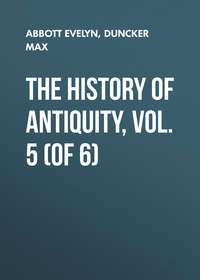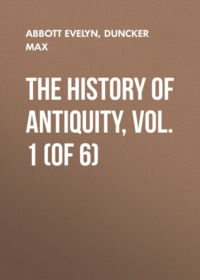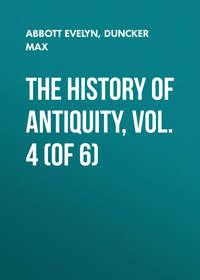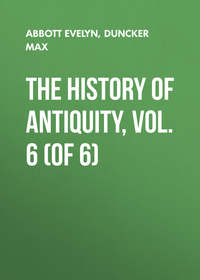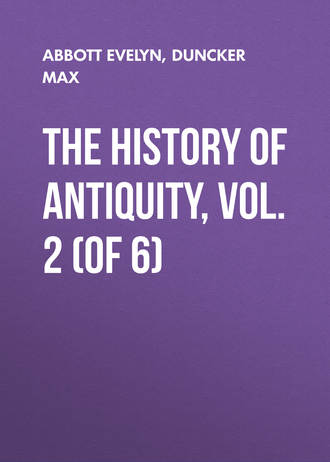 полная версия
полная версияThe History of Antiquity, Vol. 2 (of 6)
The worship of Baal Moloch, which the Phenicians brought to Crete and the shores of Megara and Attica, was not all that the Greeks personified in the form of Minos; they did not confine themselves to one side of the myth of Baal Melkarth. When Grecian colonists settled subsequently in Crete they found the cities of the Phenicians full of artistic capacity, and their life regulated by legal ordinances. Thus their legend could place the artist Dædalus, the discoverer and pattern of all art-industry, beside Minos, and refer to Minos the ordinances of the cities. Zeus himself had revealed these arrangements to him. At a later time the Greek cities of Crete traced their own institutions back to Minos; here and there they may perhaps have followed a Phenician model, or they may have given out that such a model had been followed. Plato represents Minos as receiving the wise laws which he introduced into Crete from Zeus. With Aristotle also Minos is the founder of the Cretan laws.125 In the circle of the Cabiri the sky-god Baal Samim was the protector and defender of law (I. 377).
Lastly, Minos is with the Greeks at once the representation and expression of the dominion which the Phenicians exercised in ancient times over the islands of the Ægean sea, before the settlements of the Greeks obtained the supremacy over the islands and the ships of the Greeks took the lead in these waters. In the age of the Heroes, so Herodotus tells us, Minos established the first naval empire; the Carians, who inhabited the islands, he made his subjects; they did not indeed pay tribute, but they had to man his ships whenever necessary.126 "The oldest king," says Thucydides, "of whom tradition tells us that he possessed a fleet was Minos. He ruled over the greatest part of the Greek sea and the Cyclades, which he colonised, driving out the Carians and making his sons lords of the islands."127 Minos, as a king ruling by law, is then said to have put an end to piracy.
The Phenicians could not certainly have left out of sight the largest of the islands, which forms the boundary of the Ægean sea; and the traditions of the Greeks can hardly go wrong if they make this island the centre of the naval supremacy of Minos, i. e. of the supremacy of the Phenicians over the Cyclades. Crete must have been the mainstay of their activity in the Ægean, just as Thebes was the point on the mainland where they planted the firmest foot. The title Minoa seems to lie at the base of the name of Minos, a title borne not only by the island off Megara and the city in Sicily, but also by two cities in Crete (one on the promontory of Drepanum, the other in the region of Lyctus), by some islands near Crete, a city in Amorgus, and a city in Siphnus. The name Minoa (from navah) could mean dwelling; it is certain evidence of a Phenician settlement. But the Phenicians have left traces of their existence in Crete beside the names Minos and Minoa and the forms of worship denoted by them. Coins of the Cretan cities Gortys and Phæstus exhibit a bull or a bull-headed man as a stamp. Near the Cretan city of Cydonia the Jardanus, i. e. the Jordan, falls into the sea; the name of the city Labana goes back to the Phenician word libanon, i. e. "white." Cnossus, the abode of Minos in Homer and Herodotus,128 was previously named Kairatus; Karath in Phenician means city. Itanus, in Crete (Ethanath in the Semitic form), is expressly stated to be a foundation of the Phenicians.129
With regard to the state of civilisation reached by Syria before the year 1500 B.C., we may draw some conclusions from the fact that not merely did the civilisation of Egypt influence the shepherds of Semitic race who ruled over Egypt at that period, but that Semitic manners and customs left behind traces in Egypt (I. 128). Hence we may assume that the Syrians carried their wine and their oil to the Nile at the time when their kinsmen ruled there (1950-1650 B.C.). The civilisation of Syria appears more clearly from the tributes imposed by Tuthmosis III. on Syria, which are here and there illustrated by the pictures accompanying the inscriptions of this Pharaoh. The burdens imposed on the Syrians consist not only of corn, wine, oil and horses; not only of gold, silver and iron, but also of arms and works of art, among which the pictures allow us to recognise carefully-decorated vessels. On the other hand, it is clear from the fact that the Babylonian weights and measures were in use in Syria at this time (I. 304) that the Syrians before this period were in lively intercourse with the land of the Euphrates, that even before the sixteenth century B.C. caravans must have traversed the Syrian deserts in every direction, and even then the Syrians must have exchanged the products of their land for Babylonian stuffs and the frankincense which the Arabians on their part carried to Babylon. The dependence of Syria on Egypt under the Tuthmosis and Amenophis can only have augmented the intercourse of the Syrians with the land of the Nile. Afterwards Sethos I. (1440-1400) caused wood to be felled on Lebanon; it must have been the places on the coast under Lebanon which carried to Egypt in their ships, along with the wine and oil of the coast and the interior, the wood so necessary there for building and exchanged it for the fabrics of Egypt. Wood for building could not be conveyed on the backs of camels, and the way by sea from the Phenician towns to the mouths of the Nile was far easier and less dangerous than the road by land over rocky heights and through sandy deserts. Hence, as early as the fifteenth century B.C., we may regard the Phenician cities as the central points of a trade branching east and west, which must have been augmented by the fact that they conveyed not only products of the Syrian land to the Euphrates and the Nile, but could also carry the goods which they obtained in exchange in Egypt to Babylonia, and what they obtained beyond the Euphrates to Egypt. At the same time the fabrics of Babylon and Egypt roused them to emulation, and called forth an industry among the Phenicians which we see producing woven stuffs, vessels of clay and metal, ornaments and weapons, and becoming pre-eminent in the colouring of stuffs with the liquor of the purple-fish, which are found on the Phenician coasts. This industry required above all things metals, of which Babylonia and Egypt were no less in need, and when the purple-fish of their own coasts were no longer sufficient for their extensive dyeing, colouring-matter had to be obtained. Large quantities of these fish produced a proportionately small amount of the dye. Copper-ore was found in Cyprus, gold in the island of Thasos, and purple-fish on the coasts of Hellas. When the fall of the kingdom of the Hittites and the overthrow of the Amorite princes in the south of Canaan augmented the numbers of the population on the coast, these cities were no longer content to obtain those possessions of the islands by merely landing and making exchanges with the inhabitants. Intercourse with semi-barbarous tribes must be protected by the sword. Good harbours were needed where the ships could be sheltered from storm and bad weather, where the crews could find safety from the natives, rest and fresh stores of water and provisions. Thus arose protecting forts on the distant islands and coasts, which received the ships of the native land. Under the protection of these intercourse could be carried on with the natives, and they were points of support for the collection of the fish and the sinking of mines.
In order to obtain the raw material necessary for their industry no less than to carry off the surplus of population, the Phenicians were brought to colonise Cyprus, Rhodes, Crete, Thera, Melos, Oliarus, Samothrace, Imbros, Lemnos and Thasos. In the bays of Laconia and Argos, in the straits of Eubœa,130 purple-fish were found in extraordinary quantities. The Phenicians settled in the island of Cythera in the bay of Laconia, which, as Aristotle says, was once called Porphyrussa from its purple-fish,131 and there erected that ancient temple to the oriental Aphrodite, Aphrodite in armour, just as in Attica in the deme of Athmonon they founded the temple of the Syrian Aphrodite and excavated the tombs on Hymettus.132 Midway between the straits of Eubœa and the bay of Corinth, which abounded with purple-fish, rose the strong fortress of the Cadmeia, and on Acrocorinthus the shrine of Ashera.
Herodotus and Thucydides told us above (p. 67) that the Carians inhabited the islands of the Ægean sea. These were they whom Minos had made subject to his dominion. Beside this, we are informed more particularly that the Carians had possessed the island of Rhodes, which lay off their coast, and had dwelt on Chios and Samos (I. 571). What degree of civilisation was reached by the population of the islands of the Ægean sea before the Phenicians came into relations with them may be inferred to some extent from the discoveries made in the island of Thera. In and beneath three layers of ashes and tufa caused by vast eruptions of the volcanos of this island have been discovered stone instruments, pottery of the most rudimentary kind, in part with the rudest indications of the human face and figure, and beside these weapons of copper and brass. In the upper layers of the tufa we find far better pottery decorated in the Phenician style. On Melos also, and in the tombs at Camirus in Rhodes, vessels of the same kind have been discovered; and, finally, in the highest of the layers at Thera are gold ornaments of the most various kinds, and ornaments of electron, i. e. of mixed gold and silver, all of a workmanship essentially non-Hellenic. From these facts we may draw the conclusion that the ships of the Phenicians brought to these inhabitants their earliest weapons in brass and copper, their pottery and ornaments; that the Carians of the islands, following these patterns, raised their own efforts to a higher stage, and that afterwards the Phenicians themselves settled in the islands and made themselves masters of them. Perhaps we may even go a step further. In the lower strata of the excavations at Hissarlik, on the Trojan coast, we find exactly the same primitive pottery, with the same indications of human forms, as in Thera, while in the refuse lying above this are idols and pottery adorned after Phenician patterns, which correspond exactly to the idols of Cyprus, as well as ornaments like those of Thera. Hence in this region also we may assume that the Phenicians gave the impulse and the example to the development of civilisation, and the more so as the name of the city of Adramyttion on the Trojan coast repeats the name of a Phenician foundation on the coast of North Africa (Adrames, Hadrumetum), and even Strabo ascribes the worship of the Cabiri to some places on the Trojan coast.133 Far more definite traces of the Phenician style and skill are in existence on the shore of the bay of Argos. The ancient tombs which have been recently discovered behind the lions' gate at Mycenæ are hewn in the rocks after the manner of the Phenicians. As in the ancient burying-places of the Phenicians, a perpendicular shaft forms the entrance to the sepulchral chambers; the corpses are laid in them without coffins, as was the most ancient custom in Phœnicia. The masks of beaten gold-leaf which were found on the faces of five or six of the corpses buried here are evidence of a custom which the Phenicians borrowed from the gilded faces of Egyptian coffins.134 The corpses are covered with gold ornaments and other decorations. There is a large number of weapons and ornaments of gold, silver, copper, brass and glass in the tombs; the execution exhibits a technical skill sometimes more, sometimes less practised. The ornaments remind us of Babylonian and Assyrian patterns; the idols in burnt clay are in the Phenician style; the palm-leaves and palms, antelopes and leopards which frequently occur, point to regions of the East; the articles of amber and the ostrich egg can only have reached the bay of Argos in Phenician ships. Still there are grave reasons for refusing to believe that the persons buried in this tomb are princes of the Phenicians. The numerous pieces of armour show that the dead who rest here were buried with their armour, which is not the traditional custom either with regard to the Phenicians or the Hellenes, but which Thucydides quotes as a mark of the tombs of the Carians.135 We learn, moreover, even from the Homeric poems, that the Carians loved gold ornaments, and further, that the Greeks improved their armour after the pattern of the Carians (I. 572). As we also find the double axe of the Carian god, the "Zeus Stratius" as the Greeks called him, the "axe-god," the Chars-El in the Carian language (I. 573), on some ornaments of the tombs of Mycenæ, the supposition forces itself upon us that Carians from the western islands must have occupied the shore of the bay of Argos. In any case, the tombs of Mycenæ, both from their position and their contents, announce to us that the people who excavated them and placed their dead in them were dependent on the style and skill of the Phenicians.
Can we fix the time at which the Phenicians first set foot on the islands of Hellas? Herodotus tells us that Troy was taken in the third generation after the death of Minos.136 If we put three full generations, according to the calculation of Herodotus, between the death of Minos and the conquest of Ilium, the first event took place 100 years before the second. Since, according to the data of Herodotus, the capture of Ilium falls in the year 1280 or 1260 B.C., Minos would have died in the year 1380 or 1360 B.C. The landing of the Phenicians on Thasos and the expedition of Cadmus from Phœnicia beyond the islands to Bœotia are placed by Herodotus five generations before Heracles, and Heracles is placed 900 years before his own time. If we reckon upwards from the year 450 or 430 B.C., Heracles lived about the year 1350 or 1330 B.C., and Cadmus five generations, i. e. 166⅔ years, before this date, or about the year 1516 or 1496 B.C.137 On the island of Thera, Herodotus further remarks, the Phenicians whom Cadmus left behind him there had dwelt for eight generations, i. e. 266⅔ years, before the Dorians came to the island.138 Melos was also occupied by Dorians, who asserted in 416 B.C. that their community had been in existence 700 years,139 according to which statement the Dorians came to Melos in the year 1116 B.C. With this event the Phenician rule over the island came to an end. If we assume that Thera, which is close by Melos, was taken from the Phenicians by the Dorians at the same time as the latter island, the eight generations given by Herodotus for the settlements of the Phenicians on Thera would carry us back to the year 1382 B.C. (1116 + 266⅔), a date which is certainly in agreement with his statement about the death of Minos, but contradicts the date given for Cadmus, who yet, according to the narrative of Herodotus, left behind the settlers on Thera and Thasos when he first sailed to Bœotia. Herodotus fixes dates according to generations and the genealogies of legend. The five generations which separated Cadmus from Heracles were for him, no doubt, Polydorus, Labdacus, Laius, Œdipus and Polynices; for the three generations between the death of Minos and the capture of Troy we find in Homer only two, Deucalion and Idomeneus.140 But we can still find from Herodotus' calculations how far back the Greeks placed the beginning and the end of the empire of the Phenicians over their islands and coasts. Beyond this the chronographers do not give us any help. Eusebius and Hieronymus (Jerome) place the rape of Europa in the year 1429 or 1426 B.C.; the rule of Cadmus at Thebes in the year 1427 B.C. or 1319 (1316) B.C.; the settlement of the Phenicians on Thera, Melos, and Thasos in the year 1415 B.C.; the beginning of the rule of Minos in the year 1410 B.C., or, according to another computation, in the year 1251 B.C.141
We can hardly obtain fixed points for determining the time of the settlements of the Phenicians in the Ægean sea. In the lower strata of the excavations at Hissarlik, on the coast of Troas, clay lentils have been found with Cyprian letters upon them.142 Since the Greeks declared that they learnt their alphabet from the Phenicians and Cadmus, and since as a fact it is the alphabet of the Phenicians which lies at the root of the Greek, the Cyprian letters can only have been brought thither by Phenician ships from Cyprus before the discovery of the Phenician letters, or from the islands off the Trojan coast occupied by the Phenicians, from Lemnos, Imbros and Samothrace; otherwise they must have come to the Troad at a later time by Cyprian ships or settlers, a supposition which is forbidden by the antiquity of the other remains discovered with or near the lentils. Among the sons of Japheth, the representative of the northern nations, Genesis mentions Javan, i. e. the Ionian, the Greek; and enumerates the sons of Javan: Elisha, Tarshish, Chittim, and Dodanim or Rodanim – the reading is uncertain.143 It is a question whether the genealogical table in Genesis belongs to the first or second text of the Pentateuch, i. e. whether it was written down in the middle of the eleventh or of the tenth century B.C. In any case it follows that in the beginning of the eleventh or tenth century B.C. the name and nation of the Ionians was known not only in the harbour-cities of Phœnicia, but in the interior of Syria, and the inhabitants of the islands and of the northern coasts of the Mediterranean were reckoned in the stock of these Ionians. Chittim is, as was remarked above, primarily the island of Cyprus; the Rodanim are the inhabitants of Rhodes (Dodanim would have to be referred to Dodona); Elisha is Elis in the Peloponnese, or the island of Sicily, if the name is not one given generally to western coasts and islands;144 Tarshish is Tartessus, i. e. the region at the mouth of the Guadalquivir. If Ezekiel mentions the purple which the Phenicians bring from "the isles of Elishah,"145 the islands and coasts of the Ægean sea are plainly meant, on which the Phenicians collected the fish for their purple dye. This much is clear, that at least about the year 1000 B.C. not only the islands and coasts of the Ægean were known in Syria, but even then the name of the distant land of Tarshish was current in Syria. We shall further see that as early as 1100 B.C. Phenician ships had passed the straits of Gibraltar. Hence we may conclude that the Phenicians must have set foot on Cyprus about the year 1250 B.C., and on the islands and coasts of Hellas about the year 1200 B.C.
Thucydides observes that in ancient times the Phenicians had occupied the promontories of Sicily and the small islands lying around Sicily, in order to carry on trade with the Sicels.146 Diodorus Siculus tells us that when the Phenicians extended their trade to the western ocean they settled in the island of Melite (Malta), owing to its situation in the middle of the sea and excellent harbours, in order to have a refuge for their ships. The island of Gaulus also, which lies close to Melite, is said to have been a colony of the Phenicians.147 On the south-eastern promontory of Malta there was a temple of Heracles-Melkarth,148 the foundation walls of which appear to be still in existence, and still more definite evidence of the former population of this island is given by the Phenician inscriptions found there. The island, like the mother-country, carried on weaving, and the products were much sought after in antiquity. On Gaulus also, a name mentioned on Phenician coins, are the remains of a Phenician temple. Between Sicily and the coast of Africa, where it approaches Sicily most nearly, lay the island of Cossyra, coins of which bear Phenician legends. Along with a dwarfish figure they present the name "island of the sons,"149 i. e. no doubt, the children of the sun-god whom we met with in Rhodes. On the east coast of Sicily there lay, on a small promontory scarcely connected with the mainland (now Isola degli Magnisi), the city of Thapsos, the name of which reveals its founders; Tiphsach means coming over, here coming over to the mainland. In the same way the promontory of Pachynus (pachun means wart), further to the south, and the harbour of Phœnicus are evidence of Phenician colonisation. On the south coast of Sicily, not far from the mouth of the Halycus, the Phenicians built that city which is known to the Greeks as Makara and Minoa, or Heracleaminoa; the coins of the city present in Phenician characters the name Rus-Melkart, i. e. "head (promontory) of Melkarth."150 Off the west coast of Sicily the Phenicians occupied the small island of Motye.151 On this coast of the larger island, on Mount Eryx, which rises steeply out of a bald table land (2000 feet above the sea), they founded the city of Eryx, and on the summit of the mount, 5000 feet high, they built a temple to the Syrian Aphrodite. In Diodorus it is Eryx the son of Aphrodite who builds this temple; Æneas then adorns it with many votive offerings, "since it was dedicated to his mother."152 Virgil represents the temple as being founded on the summit of Eryx, near to the stars, in honour of Venus Idalia, i. e. the goddess worshipped at Idalion (Idial) on Cyprus by the immigrants from the East, who, with him, are the companions of Æneas.153 The courtezans at this temple, the sensual character of the worship, and the sacred doves kept here (in a red one the goddess herself was supposed to be seen154), even without the Phenician inscriptions found there, would leave no doubt of its Syrian origin. The mighty substructure of the building is still in existence. Dædalus is said to have built it for the king of the Sicanians (p. 64). Beside the Syrian goddess, the Phenicians also worshipped here the Syrian god Baal Melkarth. According to the account of Diodorus, Heracles overcame Eryx in wrestling, and so took his land from him, though he left the usufruct of it to the inhabitants.155 The kings of Sparta traced their origin to Heracles. When Dorieus, the son of Anaxandridas, king of Sparta, desired to emigrate in his anger that the crown had fallen to his brother Cleomenes, the oracle bade him retire to Eryx; the land of Eryx belonged to the Heraclids because their ancestor won it. The Carthaginians, it is true, did not acknowledge this right; Dorieus was slain, and most of those who followed him.156 On the north coast of Sicily, Panormus (Palermo) and Soloeis were the most important colonies of the Phenicians. Panormus, on coins of the Phenicians Machanath, i. e. the camp, worshipped the goddess of the sexual passion; Soloeis (sela, rock) worshipped Melkarth. In a hymn to Aphrodite, Sappho inquires whether she lingers in Cyprus or at Panormus.157 Motye, Soloeis and Panormus were in the fifth century the strongest outposts of the Carthaginians in Sicily.158
On Sardinia also, as Diodorus tells us, the Phenicians planted many colonies.159 The mountains of Sardinia contained iron, silver, and lead. According to the legend of the Greeks, Sardus, the son of Makeris, as the Libyans called Heracles, first came with Libyans to the island. Then Heracles sent his brother's son Iolaus, together with his own sons, whom he had begotten in Attica, to Sardinia. As Heracles had been lord of the whole West, these regions belonged of right to Iolaus and his companions. Iolaus conquered the native inhabitants, took possession of and divided the best and most level portion of the land which was afterwards known by the name of Iolaus; then he sent for Dædalus out of Sicily and erected large buildings, which, Diodorus adds, are still in existence; but in Sicily temples were erected to himself, and honour paid as to a hero, and a famous shrine was erected in Agyrion, "where," as Diodorus remarks of this his native city, "even to this day yearly sacrifices are offered."160 Makeris, the supposed father of Sardus, is, like Makar, a form of the name Melkarth. If Sardinia and the whole West as well as Eryx is said to have belonged to Heracles, if Heracles sends out his nearest relations to Sardinia, if the artist Dædalus is his companion here as he was the companion of Minos in Crete and Sicily, it becomes obvious that the temples of Baal Melkarth on the coasts of Sardinia and Sicily lie at the base of these legends of the Greeks, that it was the Phenicians who brought the worship of their god along with their colonies to these coasts, to which they were led by the wealth of the Sardinian mountains in copper. As we already ventured to suppose (I. 368), Iolaus may be an epithet or a special form of Baal.161




